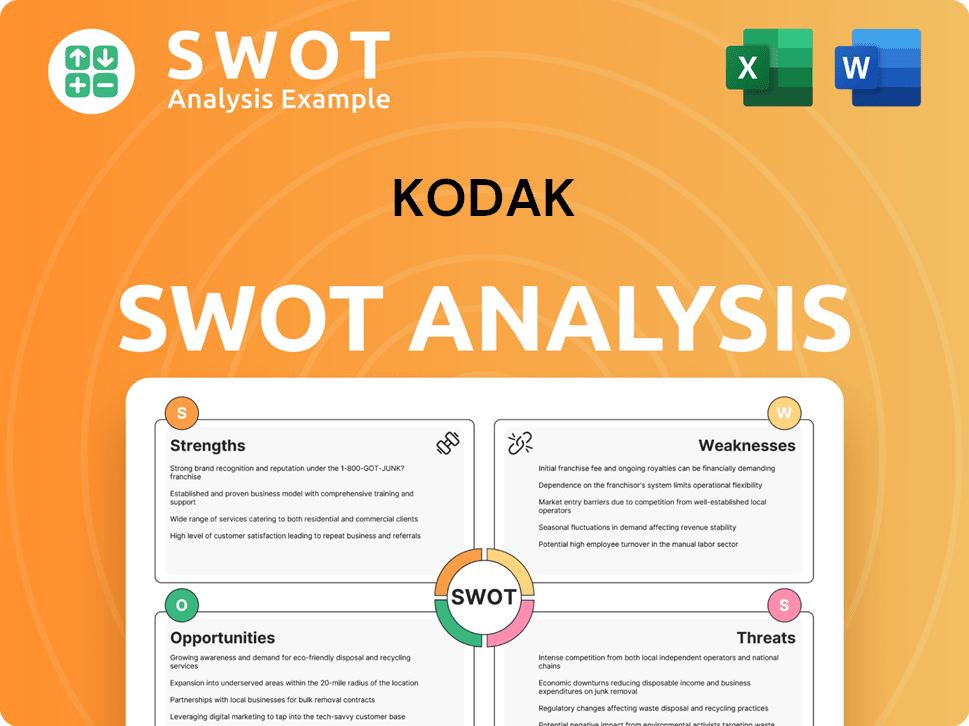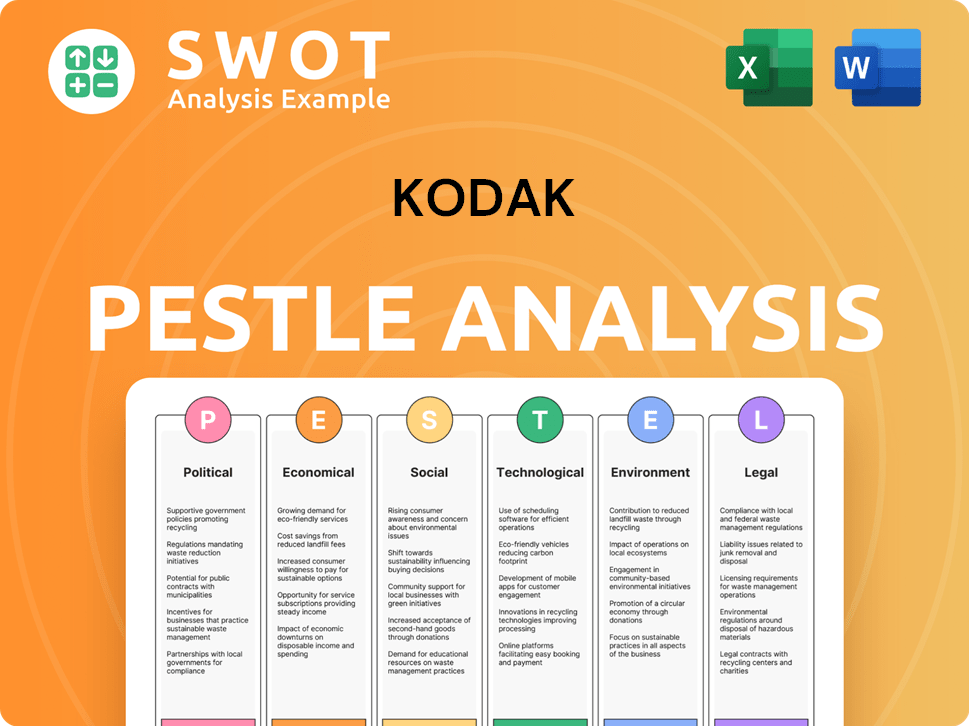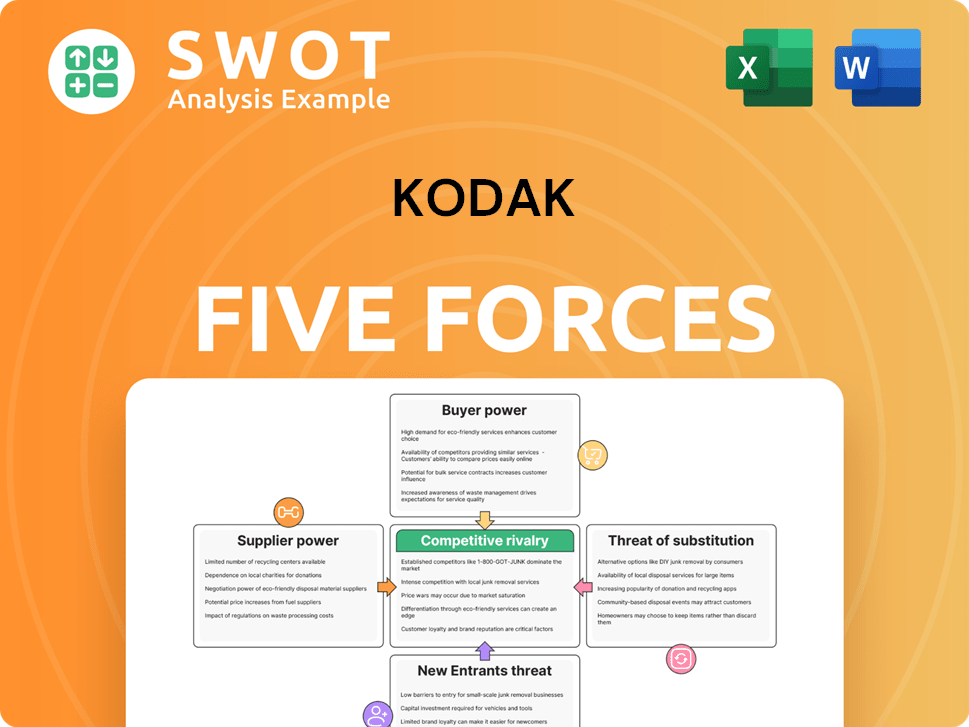Kodak Bundle
Can you believe how Kodak shaped the world we see?
Kodak, a name once synonymous with photography, revolutionized how the world captured and shared moments, shifting photography from a specialized craft to a mass-market phenomenon. Founded in 1880 by George Eastman in Rochester, New York, Kodak's mission was simple: make photography accessible to everyone. This ambitious endeavor laid the groundwork for a cultural shift in visual expression and storytelling, with Kodak introducing groundbreaking products like the first portable camera and film.

Today, Kodak SWOT Analysis reveals a company that has evolved beyond its traditional photographic film roots. From its early days with innovative Kodak cameras to its current focus on print and advanced materials, the Eastman Kodak company has experienced a remarkable journey. This article delves into the brief history of Kodak company, exploring its pivotal moments, innovations, and the challenges that have redefined its position in the industry, including its rise to prominence and subsequent decline.
What is the Kodak Founding Story?
The story of the Eastman Kodak company begins with George Eastman and his partner, Henry A. Strong. In 1880, they laid the groundwork for what would become a photography giant. Their journey started on January 1, 1881, in Rochester, New York, with the establishment of the Eastman Dry Plate Company.
George Eastman, a former bank clerk, saw the need to simplify photography. The existing process required photographers to coat plates with wet chemicals before taking each picture. This made photography difficult, limiting it to professionals and dedicated hobbyists. Eastman's innovative approach involved developing dry plates that could be prepared in advance.
His experiments in his mother's kitchen led to a series of successful dry plates and a machine to produce them efficiently. The company evolved, and on October 1, 1884, it was re-incorporated as the Eastman Dry Plate and Film Company. Eastman then focused on replacing glass plates with roll film, patenting the first practical film roll holder with William Walker in 1885.
The name 'Kodak' was created by George Eastman. He wanted a short, memorable name, and he and his mother, Maria, came up with it using anagrams.
- The first Kodak camera, introduced in 1888, changed the game.
- The camera came preloaded with a 100-exposure roll of film.
- Customers sent the entire camera back to Rochester for film development, printing, and reloading for $10.
- This innovative business model simplified photography for the masses, setting the stage for the company's growth.
Kodak SWOT Analysis
- Complete SWOT Breakdown
- Fully Customizable
- Editable in Excel & Word
- Professional Formatting
- Investor-Ready Format

What Drove the Early Growth of Kodak?
The early growth of the company, now known as Eastman Kodak, was marked by strategic innovations and expansions that solidified its place in the photography market. Following its initial success, the company refined its offerings, introducing new products and expanding its reach. This period saw the creation of iconic products and a global footprint that would define its early success.
In 1889, the Eastman Company was formed, issuing 10,000 shares of stock. The company was renamed Eastman Kodak on May 23, 1892. A significant milestone was the 1900 introduction of the Brownie camera, priced at just $1.00, making photography accessible to a broader audience. The Brownie's design, featuring a removable film container, simplified the photographic process.
The company expanded internationally, establishing Australia Kodak Limited in 1908 and later Kodak-Pathé in France and Kodak AG in Germany in 1931 through acquisitions. Recognizing the potential of the motion picture industry, it became the sole film supplier to the Motion Picture Patents Company in 1908. By 1914, the company had built its headquarters on State Street in Rochester.
The company's simplified methods and affordable products created a mass market for photography. It introduced the first commercial transparent roll film in 1889, used by Thomas Edison for his motion pictures. In 1896, the company perfected the first positive motion-picture film, further boosting the film industry. This early growth firmly established the company as a dominant force. For more insights, consider exploring the Competitors Landscape of Kodak.
The company's success was driven by figures like George Eastman, who revolutionized photography. The Kodak timeline reveals a series of innovations, including the development of early Kodak cameras. These advancements, from the Brownie camera to early film technologies, shaped the evolution of photography and the film industry, establishing the company's legacy.
Kodak PESTLE Analysis
- Covers All 6 PESTLE Categories
- No Research Needed – Save Hours of Work
- Built by Experts, Trusted by Consultants
- Instant Download, Ready to Use
- 100% Editable, Fully Customizable

What are the key Milestones in Kodak history?
The Kodak company's journey is marked by significant milestones that have shaped the landscape of photography and imaging. From its inception to its evolution, the Kodak history reflects a legacy of innovation and adaptation within a dynamic industry. The Eastman Kodak company's story is one of pioneering spirit and resilience.
| Year | Milestone |
|---|---|
| 1880 | George Eastman founded the Eastman Kodak Company. |
| 1888 | The Kodak camera was introduced, making photography accessible to the masses. |
| 1935 | Kodachrome, the first commercially successful color film, was launched. |
| 1963 | The Instamatic camera series simplified photography with cartridge-loaded film. |
| 1975 | Kodak engineers developed the first digital camera. |
| 2012 | Kodak filed for bankruptcy. |
| 2013 | Kodak emerged from bankruptcy, refocusing on commercial markets. |
The Kodak company has consistently pushed the boundaries of imaging technology. The introduction of Kodachrome film in 1935 revolutionized color photography, offering vibrant and accurate color reproduction. The company also pioneered home-movie equipment and easy-to-use color slide film, expanding its influence in the market.
Kodachrome, introduced in 1935, was a pioneering color film known for its exceptional color accuracy and saturation, significantly impacting the film industry. This innovation set a new standard for color photography, influencing generations of photographers.
The Instamatic series, launched in the 1960s, simplified photography with its cartridge-loaded film, making it accessible to a wider audience. This ease of use helped cement Kodak's position as a leader in the consumer photography market.
In 1975, Kodak engineers created the first digital camera, a pivotal invention that, if embraced earlier, could have altered the company's trajectory. This early innovation demonstrated Kodak's technical prowess.
The Disc camera series, introduced in 1982, featured advanced features like automatic flash and focus adjustment, showcasing Kodak's commitment to innovation. This technology aimed to enhance user experience and photo quality.
Pioneering home-movie equipment and easy-to-use color slide film expanded Kodak's influence in both consumer and professional markets. This diversification allowed Kodak to capture a broader market segment.
After emerging from bankruptcy, Kodak invested in digital printing technology, including high-speed inkjet presses, to cater to commercial markets. This strategic move was part of Kodak's broader shift towards commercial printing solutions.
Despite its innovations, the Kodak company faced significant challenges, particularly with the rise of digital photography. The company's slow adaptation to the digital shift and its initial reluctance to embrace digital cameras led to a decline in market share and financial difficulties. The failure to fully capitalize on its early digital camera invention proved to be a critical strategic misstep for the Eastman Kodak company.
The rapid adoption of digital photography and smartphones significantly impacted Kodak's core film business, leading to a decline in revenue. This shift in consumer behavior forced Kodak to re-evaluate its business model.
As digital cameras became more prevalent, Kodak's market share in the photography sector diminished, impacting its financial performance. The company struggled to compete with new entrants in the digital space.
In 2012, Kodak filed for bankruptcy, a direct result of its inability to adapt to the digital revolution and its reliance on legacy products. This marked a critical turning point in the company's history.
The decision not to aggressively pursue the digital camera market in its early stages proved to be a significant strategic error. This hesitation allowed competitors to gain a foothold in the rapidly evolving digital landscape.
After restructuring, Kodak entered commercial printing and packaging solutions, but faced intense competition in these new sectors. This made it challenging for Kodak to quickly establish a strong market position.
The transition from film to digital was financially taxing, leading to significant losses and the need for substantial restructuring. The company had to manage debt and reduce costs to ensure its survival.
Post-bankruptcy, Kodak has shifted its focus, with a strategic pivot towards commercial markets. The company now emphasizes commercial printing, packaging solutions, and digital imaging services. For example, in 2023, Kodak announced investments in its Advanced Materials & Chemicals (AM&C) unit, including new cGMP pharmaceutical manufacturing facilities, to expand its business in specialized materials. This strategic shift, along with a focus on operational efficiencies, reflects Kodak's ongoing efforts to adapt and build new strengths in a changing market. For more insights into how Kodak has approached its marketing strategies, you can read more about the Marketing Strategy of Kodak.
Kodak Business Model Canvas
- Complete 9-Block Business Model Canvas
- Effortlessly Communicate Your Business Strategy
- Investor-Ready BMC Format
- 100% Editable and Customizable
- Clear and Structured Layout

What is the Timeline of Key Events for Kodak?
The Kodak company's journey, from its inception to its present form, showcases a blend of pioneering innovation and strategic pivots. From its early days, when George Eastman established the Eastman Dry Plate Company, to its ventures in digital photography and, now, advanced materials, the company has consistently adapted to the evolving technological landscape.
| Year | Key Event |
|---|---|
| 1880 | George Eastman establishes the Eastman Dry Plate Company in Rochester, New York, marking the beginning of the Kodak history. |
| 1888 | The first Kodak camera is introduced, revolutionizing photography by simplifying the process for consumers and creating early Kodak cameras. |
| 1900 | The Brownie camera debuts, further democratizing photography and solidifying Eastman Kodak's market position. |
| 1935 | Kodachrome, the first commercially successful color film, is launched, significantly impacting the film industry. |
| 1975 | Kodak engineer Steve Sasson invents the first digital camera, signaling a shift towards digital imaging. |
| 2012 | Kodak files for bankruptcy, reflecting the challenges posed by the digital transition and decline. |
| 2024 | Consolidated revenues reach $1.043 billion, indicating a period of recovery and strategic realignment. |
| 2025 | A new cGMP manufacturing facility for pharmaceutical products is expected to be online, demonstrating a strategic shift into advanced materials and chemicals. |
Kodak is expanding its Advanced Materials & Chemicals (AM&C) unit, focusing on pharmaceutical manufacturing, including FDA-regulated diagnostic test reagents. A new cGMP manufacturing facility is set to commence production in 2025, highlighting a commitment to U.S.-based manufacturing. This strategic move aims to capitalize on the growing demand for pharmaceutical products.
The company is leveraging its expertise in coating technology for opportunities in the EV/energy storage battery market. Additionally, Kodak is exploring its copper micro-wire technologies for transparent heaters and antennas. They are also developing light-blocking technology for fabric coatings, diversifying its product offerings.
Kodak continues to invest in its inkjet press portfolio, with products like the KODAK PROSPER 7000 Turbo Press, the world's fastest inkjet press. Commitment to sustainable print technologies, such as KODAK SONORA Process Free Plates, eliminates chemical processing. These investments reflect Kodak's ongoing commitment to the commercial print sector.
For Q1 2025, Kodak reported consolidated revenues of $247 million, nearly flat compared to Q1 2024 revenues of $249 million. Despite a net loss of $7 million in Q1 2025, compared to a net income of $32 million in Q1 2024, the company is focusing on operational efficiency. Kodak is leveraging its pension fund reversion proceeds to reduce long-term debt.
Kodak Porter's Five Forces Analysis
- Covers All 5 Competitive Forces in Detail
- Structured for Consultants, Students, and Founders
- 100% Editable in Microsoft Word & Excel
- Instant Digital Download – Use Immediately
- Compatible with Mac & PC – Fully Unlocked

Related Blogs
- What is Competitive Landscape of Kodak Company?
- What is Growth Strategy and Future Prospects of Kodak Company?
- How Does Kodak Company Work?
- What is Sales and Marketing Strategy of Kodak Company?
- What is Brief History of Kodak Company?
- Who Owns Kodak Company?
- What is Customer Demographics and Target Market of Kodak Company?
Disclaimer
All information, articles, and product details provided on this website are for general informational and educational purposes only. We do not claim any ownership over, nor do we intend to infringe upon, any trademarks, copyrights, logos, brand names, or other intellectual property mentioned or depicted on this site. Such intellectual property remains the property of its respective owners, and any references here are made solely for identification or informational purposes, without implying any affiliation, endorsement, or partnership.
We make no representations or warranties, express or implied, regarding the accuracy, completeness, or suitability of any content or products presented. Nothing on this website should be construed as legal, tax, investment, financial, medical, or other professional advice. In addition, no part of this site—including articles or product references—constitutes a solicitation, recommendation, endorsement, advertisement, or offer to buy or sell any securities, franchises, or other financial instruments, particularly in jurisdictions where such activity would be unlawful.
All content is of a general nature and may not address the specific circumstances of any individual or entity. It is not a substitute for professional advice or services. Any actions you take based on the information provided here are strictly at your own risk. You accept full responsibility for any decisions or outcomes arising from your use of this website and agree to release us from any liability in connection with your use of, or reliance upon, the content or products found herein.